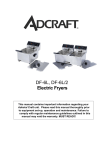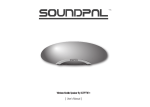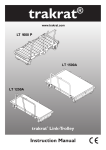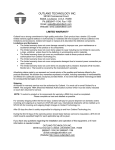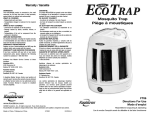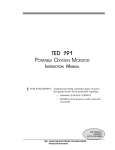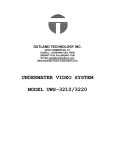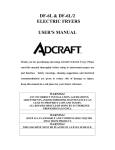Download Chicago Electric 47641 User's Manual
Transcript
INVER
TER - MODIFIED SINE
INVERTER
400 / 800 W
ATT
WA
47641
ASSEMBLY AND OPERATING INSTRUCTIONS
3491 Mission Oaks Blvd., Camarillo, CA 93011
Visit our Web site at http://www.harborfreight.com
Copyright © 2002 by Harbor Freight Tools®. All rights reserved. No portion of this
manual or any artwork contained herein may be reproduced in any shape or form
without the express written consent of Harbor Freight Tools.
For technical questions and replacement parts, please call 1-800-444-3353
Specifications
!"!#$
%
!!#&'()
&*++
"-)/
5
$
"8:"!8"8(+
;<
/+
=:>$?
*/:>$?@/
D
+
*+E-%8%
GE/
+</
GE+<
+
5
"I//
@
@/+
"%@//+++
":
@/+
"%@"@/
Save This Manual
You will need the manual for the safety warnings and precautions, assembly
instructions, operating and maintenance procedures, parts list and diagram. Keep
your invoice with this manual. Write the invoice number on the inside of the front
cover. Keep the manual and invoice in a safe and dry place for future reference.
Safety Warnings and Precautions
WARNING: When using tool, basic safety precautions should always be followed
to reduce the risk of personal injury and damage to equipment.
Read all instructions before using this tool!
1.
Do not plug in battery chargers for cordless power tools if the charger for
the power tool has a warning that dangerous voltages are present at the
battery terminals.
SKU 47641
Page 2
2.
Keep work area clean. Cluttered areas invite injuries.
3.
Observe work area conditions. Do not use machines or power tools in
damp or wet locations. Don’t expose to rain. Keep work area well lighted.
Do not use electrically powered tools in the presence of flammable gases or
liquids.
4.
Keep inverter away from any direct heat source or combustible material.
Keep well ventilated.
5.
Do not open the metal case; risk of electric shock.
6.
Keep children away. Children must never be allowed in the work area. Do
not let them handle machines, tools, or extension cords.
7.
Store idle equipment. When not in use, tools must be stored in a dry
location to inhibit rust. Always lock up tools and keep out of reach of children.
8.
Use the right tool for the job. Do not attempt to force a small tool or
attachment to do the work of a larger industrial tool. There are certain
applications for which this tool was designed. It will do the job better
and more safely at the rate for which it was intended. Do not modify this
tool and do not use this tool for a purpose for which it was not intended.
9.
Dress properly. Do not wear loose clothing or jewelry as they can be caught
in moving parts. Protective, electrically non-conductive clothes and non-skid
footwear are recommended when working. Wear restrictive hair covering to
contain long hair.
10. Use eye and ear protection. Always wear ANSI approved impact safety
goggles when using tools. Wear a full face shield if you are producing metal
filings or wood chips. Wear an ANSI approved dust mask or respirator when
working around metal, wood, and chemical dusts and mists.
11. Do not overreach. Keep proper footing and balance at all times. Do not
reach over or across running machines.
12. Maintain tools with care. Keep tools sharp and clean for better and safer
performance. Follow instructions for changing accessories. Inspect tool
cords periodically and, if damaged, have them repaired by an authorized
technician.
13. Disconnect power. Unplug inverter when not in use.
14. Avoid unintentional starting. Be sure the switch is in the Off position when
not in use and before plugging in any appliance.
15. Stay alert. Watch what you are doing, use common sense. Do not operate
any tool when you are tired.
SKU 47641
Page 3
16. Check for damaged parts. Before using any tool, any part that appears
damaged should be carefully checked to determine that it will operate
properly and perform its intended function. Check for alignment and binding
of moving parts; any broken parts or mounting fixtures; and any other
condition that may affect proper operation. Any part that is damaged should
be properly repaired or replaced by a qualified technician. Do not use the tool
if any switch does not turn On and Off properly.
17. Guard against electric shock. Prevent body contact with grounded
surfaces such as pipes, radiators, ranges, and refrigerator enclosures.
18. Servicing. Service this device only with a qualified Technician. This item
does not have any replaceable parts.
19. Do not operate tool if under the influence of alcohol or drugs. Read
warning labels on prescriptions to determine if your judgment or reflexes are
impaired while taking drugs. If there is any doubt, do not operate the tool.
20. Pacemaker safety warning. People with pacemakers should consult with
their physician(s) before using this product; operation of equipment in close
proximity to a heart pacemaker could cause interference or failure of the
pacemaker.
21. Use tools with both hands when required. Many tools such as chain
saws, drills, routers, etc., require the use of both hands when operating. This
helps maintain tool stability and keeps hands away from the working area of
the tool.
Note: Performance of this unit may vary depending on the inverter voltage, available
battery power, or appliance wattage.
Warning: The warnings, cautions, and instructions discussed in this instruction manual cannot cover all possible conditions and situations that may occur. It must be understood by the operator that common sense and caution
are factors which cannot be built into this product, but must be supplied by
the operator.
SKU 47641
Page 4
Unpacking
When unpacking, check to make sure the following parts are included. If any parts
are missing or broken, please call Harbor Freight Tools at the number on the cover
of this manual as soon as possible.
Inverter Unit
Battery Clamp
Cable
Lighter Output
Connector Cable
Operation
For the power inverter to work properly, your power source must provide between
10 to 15 volts DC, and the power source must provide enough current (i.e., 33
amps to operate the load of 400 Watts or under).
Caution: This inverter must only be connected to batteries with a nominal output voltage of 12 volts. Lower voltage will not operate the inverter properly,
and more voltage could damage it. Do not use this inverter with positive ground
electrical systems.
1.
Place the Power Inverter on a flat surface. Make sure it
has adequate ventilation and is not in direct sunlight.
Red
2.
Connect either the lighter output connector cable or the
battery clamp cable lugs to the red and black terminal
screws on the back of the inverter. Securely tighten.
3.
The Power Inverter can be used either while the engine is Black
running or off. Insert the Lighter Output Connector Cable
plug firmly into the cigarette lighter socket. Or, connect the Battery Cable
Clamps to the negative (black) and Positive (red) terminals of the battery.
4.
Plug the 110 VAC device(s) you wish to power into the 3-prong AC
Receptacles. See photo on the next page. The appliance(s) must not use
more than 400 (total) watts during continuous operation.
SKU 47641
Page 5
Power Indicator
Overload Indicator
3-prong AC
Recepticles
Power Switch
Caution: Some rechargeable appliances may damage the Power Inverter or the
appliance. When first using a rechargeable device, check its temperature for
the first 10 minutes. If it becomes abnormally hot, do not use this device with
the Inverter.
5.
Flip the Power Switch to the On (I) position to turn on. Do not use the
appliance until the green power LED indicator is on.
6.
Turn on appliance. If the red overload LED indicator comes on, or an alarm
sound is heard, turn off the appliance.
Caution: It is recommended that the vehicle be started every hour to recharge
the battery system. Doing this will prevent any unexpected shutdown of the
equipment. This will also ensure that there will be enough battery power to
start the vehicle.
Appliance Power Consumption
The Appliance Power Consumption table below gives general use wattage. Always
verify the appliance wattage before using.
SKU 47641
G
{{
+/
||
$
==
!+}
{
*
$
'
:
Page 6
Maintenance
This device does not contain any replaceable parts. If it needs service take it to a
qualified technician.
Troubleshooting Tips
1.
If the low battery alarm sounds, this means that the input voltage is below the
necessary 10.7 V. The battery needs recharging. You should stop using the
appliance and then recharge the battery. If this is not done the Inverter will
shut off automatically at around 10.0 V.
2.
The Inverter will automatically shut down if the input voltage exceeds 15 volts
DC.
3.
The Inverter will shut down when the internal temperature reaches unsafe
levels. You may restart the inverter by turning the rocker switch to Off, waiting
15 minutes, and then pushing the rocker switch back to On.
4.
If you are unsure if the inverter will have the proper amount of current to run
the device, use this rough guideline: Take the power consumption of the load
in watts and divide it by 12 (input voltage). The result will be the number of
amps needed to power your device.
Example: Load is rated at 320 watts. 320 watts / 12 V = 26 amps needed.
You could use this device with the inverter.
5.
If your television will not start it is important to keep in mind that some
appliances may require two to six times their wattage to start up. This
inverter will not work with such devices.
6.
Your power tools start up but don’t continue to run: Try leaving the power to
the tool on, while quickly but repeatedly turning the inverter power switch On
and Off.
7.
If your audio system buzzes while using this inverter, it is because some
sound systems can not filter out the modified sine wave produced by the
inverter. The only solution is to use a sound system that incorporates a
higher quality power supply.
8.
This inverter is made to minimize the interference with TV signals. However,
especially with weak TV signals, some interference may still be visible. To
correct this, place the inverter as far away as possible from the television
antenna and it’s cables. Next, adjust the orientation of the inverter to the
antenna cables and TV power cord to minimize the interference. Also use a
shielded antenna cable.
SKU 47641
Page 7
9.
If the low battery alarm is on all the time try these corrective measures:
Recharge battery if in poor condition. Next, check the condition of the lighter
cable plug and the socket. You may need to clean the socket.
10. If you are getting a low output voltage, try reducing the load to minimize watts.
You may have overloaded the inverter. Reduce your load to 140 watts. Also,
keep input voltage above 10.5 volts to maintain a constant flow of power.
11. If you are not getting any power output, turn the power switch Off, and On
again, until the green power light comes on. Some automotive systems
require that the ignition be turned on. Turn the ignition to the accessory
position. Your devices may draw too much power to operate them. The
inverter may be in thermal shutdown. Let it cool down and make sure there is
adequate ventilation around the unit.
SKU 47641
Page 8








